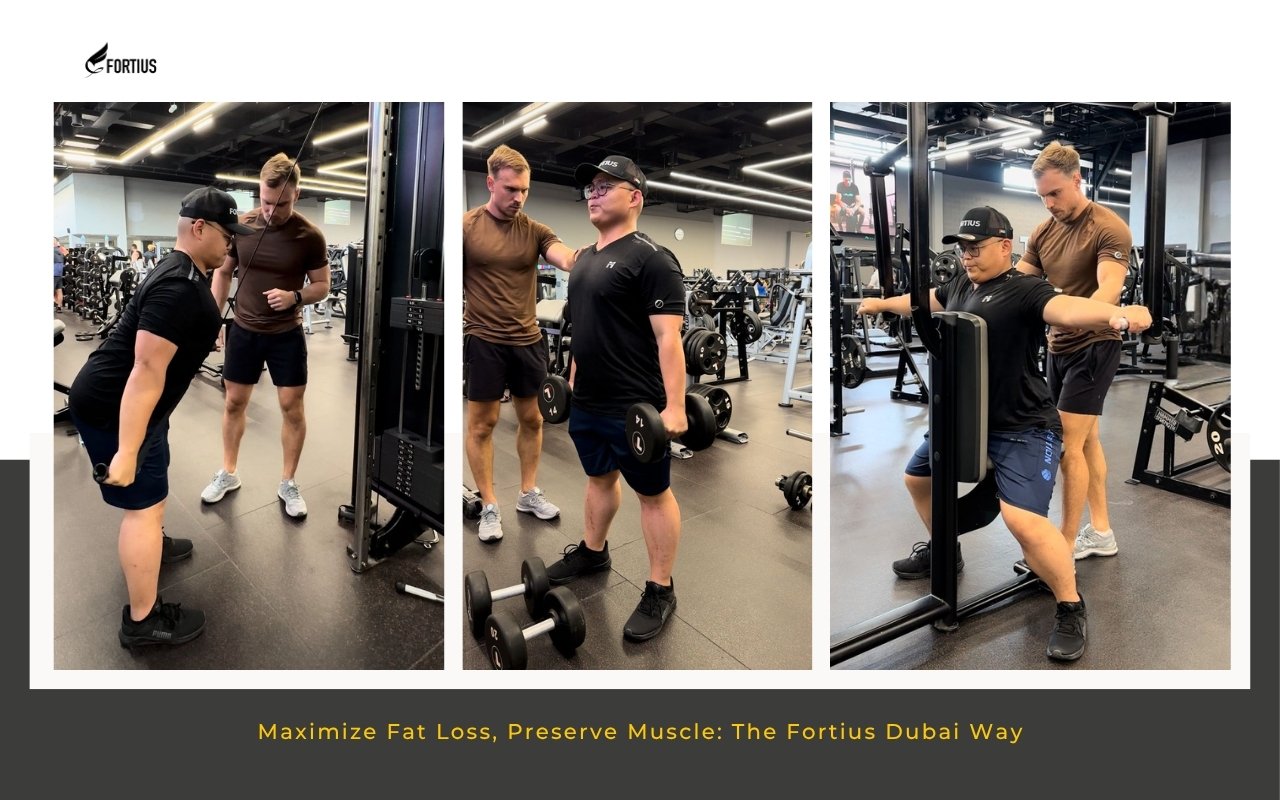Exercising on Mounjaro or Ozempic: A Dubai Trainer's Guide to Preventing Muscle Loss & Maximizing Fat Loss
A Personal Message from Milos Tanasic, Founder & Head Coach of Fortius Dubai
As a coach in Dubai for many years, I've seen countless fitness and weight loss trends come and go. Today, one of the most significant conversations in our city—and globally—revolves around new-generation weight loss medication like Ozempic and Mounjaro. Let me be clear: these GLP-1 agonists are incredibly powerful tools that are helping many individuals with chronic weight management achieve significant weight reduction. I see this as a potential starting point for a new, healthier life.
However, I also see a critical, dangerous gap in the conversation. The scale might be dropping, but what kind of weightis actually being lost? My biggest concern is the alarming rate of muscle loss I see in individuals using these weight loss drugs without a concurrent, expertly-guided fitness plan.
This guide provides the specific training and nutrition strategy for anyone using these medications. Before diving into the exercise protocol, it's important to understand the bigger picture of how these drugs work, their benefits, and their risks. For that complete overview, we recommend first reading our Ultimate Guide to Weight Loss Medications in Dubai.
Losing body weight is one thing; transforming your body into a strong, metabolically healthy, and functional machine is another entirely. This guide is my professional advice on how to bridge that gap. It’s for anyone in Dubai on this specific weight loss journey who wants to ensure they are losing the right kind of weight (fat) while preserving muscle—the most valuable tissue they have.
The Double-Edged Sword: Understanding How These Medications Work
These medications primarily work by mimicking hormones that target areas of the brain that regulate appetite and slow digestion. For instance, some mimic GLP-1, while others also target the glucose-dependent insulinotropic polypeptide receptor. This leads to a significant reduction in your daily calorie intake. When you eat fewer caloriesthan you burn, your body seeks energy from its stored reserves, aiding in reducing body weight. While clinical trialsshow impressive weight loss, they don't always focus on the quality of that loss, which is where your exercise habitsbecome crucial.
The Hidden Danger: Why Muscle Loss Sabotages Your Long-Term Health
When a significant portion of your weight loss comes from muscle, you are setting yourself up for future challenges. This isn't just about aesthetics; it's about your fundamental, overall health.
A Slower Metabolism: Muscle tissue burns more calories at rest than fat tissue. Losing lean muscle massmeans your metabolism slows down, making it incredibly easy to regain weight once the medication is stopped or the body responds by adapting.
A "Skinny Fat" Physique: This is the ultimate paradox. You weigh less, but your body fat percentage is still high. You lack muscle tone, appear soft, and don't have the strength or shape you desire. Your Body Mass Index (BMI) might be "normal," but your body composition is unhealthy.
Reduced Functional Strength: Everyday life becomes harder. Carrying groceries, playing with your children, and staying active requires muscle. Losing it compromises your physical capabilities and quality of life, and can even lead to issues like joint pain.
Poor Metabolic Health: Muscle plays a crucial role in blood sugar control. Losing muscle mass can negatively impact insulin sensitivity over the long term, which is counterproductive, especially for those using these medications to help treat diabetes or related underlying health conditions.
The Fortius Dubai Blueprint: Your Strategy to Maximize Fat Loss & Preserve Muscle
If you are using these medications as part of a weight loss program, it is imperative that you adopt a structured exercise plan. Here is the blueprint my team and I implement for our clients in Dubai.
Pillar 1: Prioritize Resistance Training (This is Non-Negotiable)
This is the single most important action you must take to maintain muscle mass.
Why: Lifting weights sends a powerful signal to your body to hold onto—and even build—muscle tissue. It tells your body, "This tissue is essential, don't burn it for fuel!"
How: Aim for 2-4 structured resistance training sessions per week. This weight training should focus on compound movements (like squats, deadlifts, presses, and rows) that work major muscle groups. This is far more effective than isolated exercises. You can use free weights, machines, resistance bands, or even structured body weight exercises like push ups. The key is that the stimulus is challenging enough to build muscle mass.
Progressive Overload: You must aim to get progressively stronger over an extended period by gradually increasing the weight, repetitions, or sets, always maintaining proper form.
Pillar 2: Fuel Your Body with High-Quality Protein
You cannot protect your muscle from a calorie deficit without providing the raw materials to repair and maintain it.
How: A high protein diet is essential. I recommend my clients aim for 1.6 to 2.2 grams of protein per kilogram of their target body weight. Distribute this protein intake across 3-4 meals throughout the day. A balanced diet rich in lean protein is fundamental.
You can use our FREE weight loss calculator to figure out your target protein intake for preserving muscle during your weight loss journey!
Pillar 3: Approach Cardio Strategically for Heart Health
Many people on these medications experience fatigue. Intense exercise can exacerbate this and further increase the risk of muscle breakdown in a deep calorie deficit.
How: I suggest prioritizing moderate intensity aerobic exercise. This could be brisk walking on an incline, light cycling, or using the elliptical. This approach offers significant benefits for cardiovascular health and heart health without adding excessive stress. Keep vigorous intensity aerobic exercise (like high intensity interval training or HIIT) to a minimum, perhaps once a week at most, and only if you feel your energy levelspermit and your perceived exertion is manageable.
Pillar 4: Hydration and Electrolytes are Crucial
In a hot climate like Dubai's, proper hydration is a serious concern that affects both your health and your ability to perform exercises.
How: Make a conscious effort to drink plenty of water. Consider adding an electrolyte supplement, especially around your workouts, to replenish what's lost through sweat.
Pillar 5: Listen to Your Body and Adjust
Side effects like fatigue and nausea can vary day by day.
How: Do not force yourself through a vigorous intensity activity on a day you feel unwell. It's better to opt for a lower, moderate intensity session, a walk, or even gentle stretching. Pushing too hard when your body is under-fueled and stressed is a recipe for injury and burnout.
Why Professional Guidance is Essential During This Process
I cannot stress this enough: navigating this weight loss journey alone is a risk. Before starting any new exercise routineor making changes to your nutrition, you should discuss your medical history with your healthcare provider. Then, working with an experienced coach is essential:
Personalization: A professional can design a safe, progressive exercise program tailored to your fitness level and goals, helping you avoid issues like joint pain.
Safety & Technique: They will ensure you are performing exercises with proper form to prevent injury.
Objective Adjustments: A coach can objectively assess your progress and make necessary adjustments to your training and nutrition plan.
Accountability & Motivation: On days when you feel tired, having a scheduled session with a trainer or fitness group provides the accountability you need to stay consistent with your regular exercise and healthy habits.
Conclusion: A Tool, Not a Magic Bullet
Weight loss medication can be a powerful catalyst for change, providing a window of opportunity to lose weight and improve conditions like high blood pressure or poor blood sugar control. However, they are a tool, not a complete solution.
The true, lasting transformation happens when you use that opportunity to build a stronger, more resilient, and metabolically healthier body. The secret isn't just reducing body weight; it's about changing your body composition to achieve sustainable weight loss and overall health. By prioritizing resistance training and proper nutrition, you ensure that the person who emerges from this journey is not just lighter, but genuinely stronger, healthier, and equipped for a lifetime of vitality.
If you are currently using these medications in Dubai and are serious about achieving a true body transformation—one that maximizes fat loss while preserving muscle—then I invite you to act. Book a complimentary consultationwith my team at Fortius Dubai. Let's discuss your situation and build a safe, effective, and personalized exercise plan to ensure your results are not just remarkable, but also sustainable and healthy.
FAQ (Frequently Asked Questions)
-
A: I recommend a minimum of two full-body strength training sessions per week, with three to four sessions being optimal for most individuals to provide an adequate muscle-preserving stimulus. The key is consistency and ensuring adequate muscle recovery time.
-
A: Listen to your body. On days of severe fatigue or nausea, it's best to prioritize rest or opt for very light physical activity like a short walk or gentle stretching. On days you feel moderately fatigued, a lower-intensity workout is better than nothing. Never push through intense pain or dizziness.
-
A: While building muscle mass is more challenging in a deep calorie deficit, it is absolutely possible, especially for those new to resistance training. For this to happen, a high protein diet and a very well-structured progressive training program are non-negotiable. For many, the primary goal will be muscle preservation, which is itself a huge victory.
-
A: I wouldn't say it's always a "bad" idea, but it should be approached with extreme caution. Due to the lower calorie intake and potential for fatigue, your ability to recover from very intense exercise is reduced. I would advise my clients to focus on strength training and moderate intensity aerobic exercise first, only incorporating HIIT sparingly and on days they feel exceptionally energetic.







